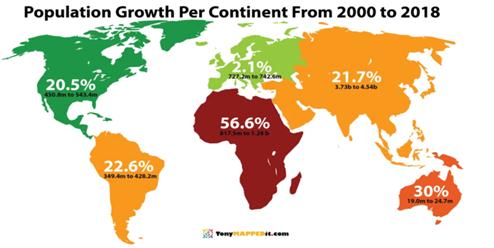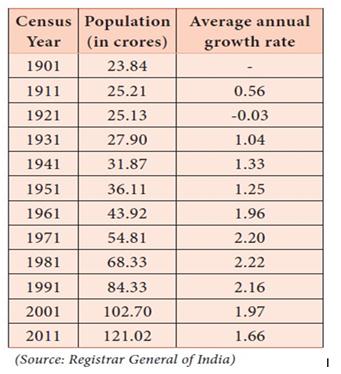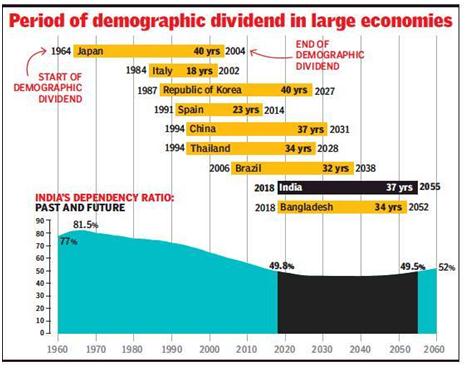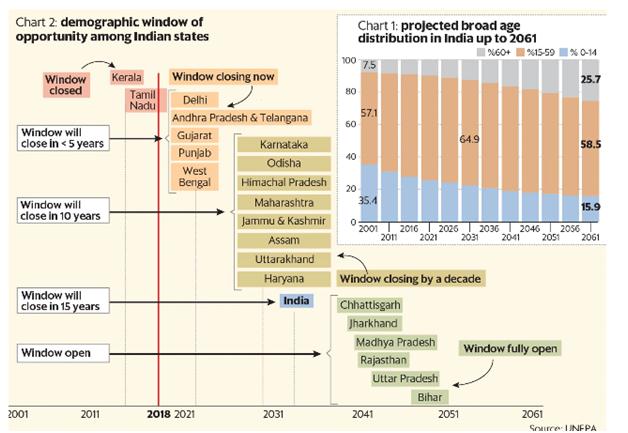Harnessing demographic dividend of India
- The Covid-19 pandemic has amplified the challenges to the youth as regards employment opportunities.
- The policy steps taken by the government have led to a slowdown in economic activities, leading to loss of jobs and mass unemployment.
Introduction
- The Covid-19 pandemic has amplified the challenges to the youth as regards employment opportunities.
- The policy steps taken by the government have led to a slowdown in economic activities, leading to loss of jobs and mass unemployment.
- According to the report, ‘Covid-19 and the world of work’ by the International Labour Organisation around 94 percent of the world’s workers are living in countries with some sort of workplace closure measures in place.
India’s demographic dividend
- The Indian population is over 135 crore people. That’s around 17% of world population. Over 62%of India’s population is between productive ages of 15-59 years.
- The medianage of the country’s population is less than 30 years of age and for next 20 years, the country will hold onto the claim of being one of the younger demographics in the world.
- The risk the country may over next few decades is : Ability of a millennial or 21st century Indian, potentially forced to retire from full-time income generating activity by age 45-50 (as gig economy sets in the Indian job markets), to sustain on her / his accumulated savings, in a low-savings-interest-rate era with increasing “services-inflation”, “food inflation” & “healthcare costs”, and negatively impacting their emotional / mental well being.
- Also, the case in point being that human longevity is increasing by the year.
Assessing the challenges to demographic dividend amidst the Covid-19 pandemic:
- Shift from the agricultural sector: There is a gradual shift from the agricultural sector and manufacturing sector to non- manufacturing sector and service sector. The challenges faced by the youth include lack of knowledge on where and how to look for jobs, outdated skills that do not address the labour demands, and education and job mismatch.
- Effect of Covid-19 lockdown: India is facing a huge unemployment problem with 6.1 percent overall unemployment, which is the highest in 45 years. Covid-19 lockdown has slowed the economic growth and led to structural weakness in the financial sector.
- Lack of Education: 28 percent youth in India belong to the age group of 15-29 years. Half of the youth have less than secondary education or are illiterate and only 13 percent are graduate. Only 5.5 million additional jobs had been created in the country during 2017-18 against 8 million youth, who entered into the job markets.
- Challenges faced by the youth: Challenges faced by the youth during the pandemic can be attributed to institutional failure; ill organised labour market and skill mismatch; low prevalence of technical training among youth workforce; and demand drive employment and supply driven education.
- Unemployment among women: There was massive unemployment among women in both urban and rural regions during the lockdown. Urban women lost their jobs, while the household chores of women in the rural regions increased. Data of CMIE suggests that 27 million youth in the age group of 20-30 years lost their jobs in April 2020.
- The unemployment rate among male youth is 18.7 percent while among female youth is 27.2 percent. The work participation rate among male is three-fifth while that among females is one-fifth. Among graduated youth, the figures are 47.7 percent for males and 29.7 percent for females.
How to harness demographic dividend amidst the Covid-19 pandemic?
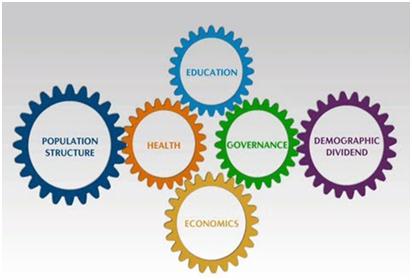
- Urgent demand for comprehensive policies: There is an urgent demand for comprehensive policies that protect the youth and create new employment opportunities. Keeping this in mind, on the occasion of the world population day, the Center for Work and Welfare, Impact and Policy Research Institute (IMPRI), New Delhi organized a panel discussion on ‘Harnessing the demographic dividend amidst the Covid-19 pandemic in India: The way forward for youth employment and opportunities’.
- Quality education and skills training: India’s growing population with the highest youth population i.e. 28 percent of the total population poses a challenge and is a demographic dividend if equipped with quality education and skills training, and decent and relevant jobs. This could lead to the country’s economic development.
- Demographic shift: The median age of the population is 28 years in India, 48.6 years in Japan and 42 years in China. This numerical data clearly shows the demographic advantage in favour of India as of now. But things are likely to change with time. While 51 percent of people were below the age of 20 in the 1970s, now it is 41 percent and will decline to 22 percent in 2050, resulting in a demographic shift. By 2050, India will lose its demographic advantage.
- Need to employ more women: Without considering the female workforce participation rate – the core of the demographic dividend, we cannot get a true picture.
- Youthful workforce needs to be employable: For India to reap the demographic dividend, its youthful workforce needs to be employable. The data on employment indicates that we have the highest rate of unemployment i.e. 15 to 29 percent. With the impact of the pandemic on employment and economic activities, India is already set to miss its demographic dividend.
- Government schemes: There are opportunities for the youth in the private sector and government schemes such as Atma Nirbhar Bharat, assured employment schemes, expansion of apprenticeship and training and curriculum as per industry.
Population growth and overpopulation
- Overpopulation indicates a scenario in which the population of a living species exceeds the carrying capacity of its ecological niche.
- Overpopulation is not a function of the number or density of the individuals, but rather the number of individuals compared to the resources they need to survive. In other words, it is a ratio: population over resources.
- In the case of human beings, there are others such as arable land and, for all but tribes with primitive lifestyles, lesser resources such as jobs, money, education, fuel, electricity, medicine, proper sewage and garbage management, and transportation.
- Presently, every year the world's human population grows by approximately 80 million. About half the world lives in nations with sub-replacement fertility and population growth in those countries is due to immigration. The United Nations projects that the world human population will stabilize in 2075 at nine billion due to declining fertility rates.
Size and growth of population in India
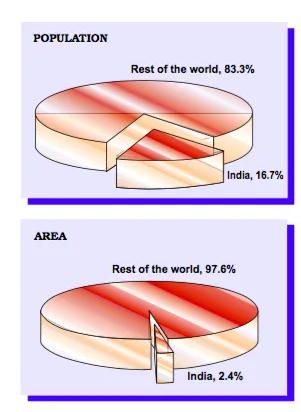
- The rapid and excessive increase in population is called Population Explosion. In India, population has increased tremendously in post-independence period.
- It increased more than 7.80 crore between 1951-61. Population has been increasing constantly since 1951.
- In year 1991, it was estimated 84.63 crore and in 2001, it increased to 102.87 crore. In 2005 figure stood at 109.10 crore. The rapid rate of increase in population is the main problem of the country.
- India comes second to China as regards the size of its population. It occupies 2.4% of world’s area and with 1.5% of world’s income; India is maintaining 16% of world’s population. It shows that there is excessive burden of population in India. 1.60 Crore persons are added annually in country’s population. First census took place in 1891 in India. Size and Growth of India’s population are shown in Table.
Demographic dividend of India and other Asian economies:
India enters 37-year period of demographic dividend:
- Since 2018, India’s working-age population (people between 15 and 64 years of age) has grown larger than the dependant population — children aged 14 or below as well as people above 65 years of age. This bulge in the working-age population is going to last till 2055, or 37 years from its beginning.
- Many Asian economies — Japan, China, South Korea — were able to use this ‘demographic dividend’, defined by the United Nations Population Fund (UNFPA) as the growth potential that results from shifts in a population’s age structure.
- This transition happens largely because of a decrease in the total fertility rate (TFR, which is the number of births per woman) after the increase in life expectancy gets stabilized.
Japanese demographic-dividend:
- Japan was among the first major economies to experience rapid growth because of changing population structure. The country’s demographic-dividend phase lasted from 1964 to 2004.
- An analysis of the first 10 years since this phase shows how such a shift in the population structure can propel growth. In five of these years, Japan grew in double digits; the growth rate was above 8% in two years, and a little less than 6% in one. Growth slid below 5% in only two of these 10 years.
Chinese demographic-dividend:
- China entered this stage in 1994 — 16 years after Deng Xiaoping’s economic reforms started in December 1978. Although its growth accelerated immediately after the reforms, the years of demographic dividend helped sustain this rate for a very long period.
- In the 16 years between 1978 and 1994 (post-reform, pre-dividend) China saw eight years of double-digit growth. In the 18 years since 1994 there have been only two years when China could not cross the 8% growth mark.
Study on demographic dividend in India by United Nations Population Fund (UNFPA)
- A study on demographic dividend in India by United Nations Population Fund (UNFPA) throws up two interesting facts.
- Demographic dividend opportunity: The window of demographic dividend opportunity in India is available for five decades from 2005-06 to 2055-56, longer than any other country in the world.
- This demographic dividend window is available at different times in different states because of differential behaviour of the population parameters.
- First set of states: The first set of states are in the southern and western parts of India and includes Kerala, Tamil Nadu, Delhi, Andhra Pradesh, Telangana, Gujarat, Punjab and West Bengal, where this window of demographic dividend opportunity is about to close, in the next five years.
- Second set of states: Then there are states where this window will remain open for another 10-15 years and include Karnataka, Odisha, Himachal Pradesh, Maharashtra, Jammu and Kashmir, Assam, Uttarakhand and Haryana.
- The third set of states: These include the high-fertility states in the hinterland of India—Chhattisgarh, Jharkhand, Madhya Pradesh, Rajasthan, Uttar Pradesh and Bihar. The window of demographic dividend opportunity is yet to open in these states. These states will have demographic dividend opportunity even in the 2050s and 2060s.
- The key finding of the study is that states will have their demographic dividend opportunity at different times because of the staggered nature of demographic transition. As a result, India will enjoy a longer span of demographic dividend because, as the window closes in some states, it will open in other states. This is an important finding as it can guide the socio-economic development policy planning according to the age and sex structures in states or a set of states.
India’s Aged: Needs and Vulnerabilities
Declining fertility and longer life expectancy mean the number of older adults is growing faster than the number of children and there is a rapid increase in old-age dependency ratio. Generally, population ageing is associated with physical and economic dependency, and falling labour force participation and income. Some of the issues associated with ageing in India are as follow:
Economic Dependency
- Ageing comes with higher incidence of activities of daily living (ADL) and instrumental activities of daily living (IADL), leading to the specific requirement of long-term care.
- The elderly from the households that are deprived within their social groups have a higher probability for being economically disadvantaged and dependent; however this varies among various socio-economic status (SES) categories.
- Individually deprived elderly persons are more likely to be weak and dependent across any SES identity.
Health Expenditure
- By 2030, the elderly will bear nearly half of the total disease burden in India. The elderly are more exposed to non-communicable diseases and chronic diseases, especially to cardiovascular disease and chronic pulmonary disease, diabetes, and cancer, requiring multiple health visits to outpatient departments and for hospitalisation.
- There will be an estimated an increase in inpatient cost by 148% and in outpatient cost by 67% over 10 years. This will have severe implications for older persons and households in the absence of weak pension and health insurance coverage along with already weak health centres in India, on meeting existing goals.
- Increasing nuclear family living arrangements and female employment outside the home and high youth outmigration have created a severe challenge for the elderly, particularly in situations requiring long-term physical support.
Living Arrangements and Family
- In the case of India, it is mostly family members who are the primary financial and physical carers; approximately 90% of the elderly are receiving help from their family. Most of them live in intergenerational settings. Of the family members, mostly daughters-in-law provide care followed by spouse and son.
- Besides, we should not overlook the 5% elderly living alone and 12% living with their spouses. This group must be in desperate need of physical and financial support.
Demography:
- Systematic study of population: Demography is the systematic study of population. Demography studies the trends and processes associated with population including – changes in population size; patterns of births, deaths, and migration; and the structure and composition of the population, such as the relative proportions of women, men and different age groups.
- Processes of counting: All demographic studies are based on processes of counting or enumeration – such as the census or the survey – which involve the systematic collection of data on the people residing within a specified territory.
- There are different varieties of demography, including formal demography which is a largely quantitative field, and social demography which focuses on the social, economic or political aspects of populations.
- Demography is concerned with how large (or how small) are the populations; how the populations are composed according to age, sex, race, marital status, and other characteristics; and how the populations are distributed in physical space (e.g., how urban and rural they are).
- Demography is also interested in the changes over time in the size, composition, and distribution of human populations, and how these result from the processes of fertility, mortality, and migration.
|
Importance of Demographic study:
For the Economy
- The study of demography is of immense importance to an economy. Population studies help us to know how far the growth rate of the economy is keeping pace with the growth rate of population.
- The government can undertake appropriate measures to control the growth of population and to accelerate the development of the economy.
For Society:
- Population studies have much importance for the society. When population is increasing rapidly, the society is faced with innumerable problems. Shortages of basic services like water, electricity, transport and communications, public health, education, etc. arise.
- Along with these, problems of migration and urbanisation are associated with the growing population which further lead to the law and order problem.
- Faced with such problems which are the concomitant result of population growth, the state and non-government social organisations can adopt appropriate measures to solve them.
For Economic Planning:
- Data relating to the present trend in population growth help the planners in formulating policies for the economic plan of the country.
- They are kept in view while fixing targets of agricultural and industrial products, of social and basic services like schools and other educational institutions, hospitals, houses, electricity, transport, etc.
For Administrators:
- Population studies are also useful for administrators who run the government.
For Political System:
- The knowledge of demography is of immense importance for a democratic political system.
- It is on the basis of the census figures pertaining to different areas that the demarcation of constituencies is done by the election commission of a
Conclusion:
The challenge created by the pandemic need solutions which help generate employment such as decentralisation of the economy, deregulation of the economy, reimagining the economic approaches, promotion of small scale industries.

